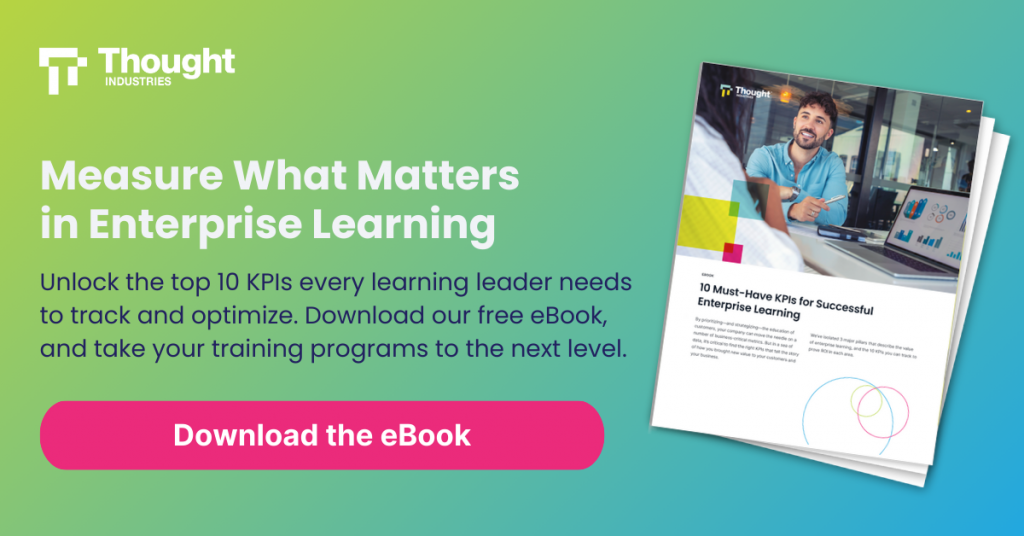A defined learning management system (LMS) strategy is essential for any organization to maximize its return on investment (ROI) and boost learner engagement. However, to be effective over the long term, the implementation of the LMS must align with organizational goals, support the company’s training needs, and drive measurable results.
Without a solid LMS strategy, your business may waste resources, encounter low user adoption, and watch many of its LMS features go unused. Adjusting your rollout plans to account for organizational requirements will help prevent these issues, enabling a smooth launch and a more engaged learning experience.
Here are six key strategies to help your team successfully implement a new learning management system and avoid common missteps.

Define Clear Objectives and Goals
A great place to start is by defining your company’s objectives and expectations when it comes to a successful LMS implementation. Establishing what success looks like for your enterprise LMS will allow both your administrators and learners to work toward defined outcomes, making it easier to measure progress and impact.
For administrators, set measurable goals like tracking user engagement rates, course completion, or certification achievements.
For learners, focus on milestones that reflect knowledge retention, professional growth, and skill development.
In addition, strive to match these objectives with your company’s broader organizational strategies—increasing employee productivity, meeting compliance training requirements, or developing workforce skills.
When LMS goals mirror the organization’s direction, the system becomes a powerful tool for achieving meaningful, long-term results.
Engage Stakeholders Early
From the very beginning, get key stakeholders involved in the implementation. Gathering input from HR, IT, trainers, and employees will help you set up a system that meets everyone’s needs and integrates smoothly into existing workflows. Early involvement also allows each group to voice their requirements and concerns so you can tailor the learning management platform to your organization’s unique environment.
Be sure to communicate the LMS platform’s benefits—including its customizable and scalable training content, accessibility, customized learning paths, and accurate tracking of learning outcomes—to demonstrate its value. Additionally, share how it will simplify HR processes, increase data security for IT, and improve the employee learning experience.
Setting clear expectations upfront and addressing potential challenges secures stakeholder buy-in and helps create advocates supporting the LMS’s successful rollout and use.
Plan the LMS Rollout
As your LMS implementation team gets to work, have them use a phased approach to minimize disruptions and facilitate the transition. Begin with a pilot phase to test features, gather feedback, and adjust the LMS interface and its training programs before the full launch.
Building cross-functional teams, including IT, HR, instructional designers, trainers, and end-users, helps guarantee well-rounded support throughout the implementation. Each team can handle specific needs, from technical requirements to creating engaging content to overseeing user training efforts.
To help with the technology transition, create a detailed timeline outlining key milestones and possible challenges. Also, consider using project management tools, communication platforms, and learning modules that facilitate collaboration, track progress using key performance indicators (KPIs) like ‘stickiness,’ and provide easy access to updates.
By carefully planning and managing each phase of the rollout, you’ll set your users up for success, help them adapt to the new system, and maximize the LMS’s long-term impact.
Customize LMS to Fit Organizational Needs
It’s vital that your LMS be tailored to your organization’s specific needs so the platform truly serves its users. A customizable LMS will allow you to adapt its features, branding, and interface to match your company’s style and values.
Structure courses, modules, and learning resources to reflect your company’s internal hierarchies so the content is organized and intuitive for your users. Furthermore, optimize your LMS for mobile devices and accessibility so learners of all kinds find it convenient and easy to use, whether in the office or on the go.
Customizing your LMS training platform will help ensure that employees find it relevant, usable, and engaging.
Prioritize a User-Centric Design
Along the same lines, make sure your LMS is mobile-friendly and easy to navigate. You’ll want users to be able to access it from any device.
Similarly, strive to design courses that accommodate all kinds of learning styles to be effective for everyone, including auditory, hands-on, and visual learners. Take measures to ensure the platform is inclusive and accessible to all, especially regarding ADA compliance regarding color palettes, variable font sizes, closed captioning, and more accessibility measures.
These efforts will result in a supportive environment of continuous learning for every user.
Training and Onboarding for Your LMS
Another important part of a successful LMS strategy and implementation is setting up effective training and onboarding that helps your users adapt to the platform. Start by offering hands-on sessions that guide employees through key features so they feel comfortable navigating the course materials and system.
Leadership also plays an integral role in LMS adoption. Senior management should actively endorse the LMS project, model the platform’s use, and encourage participation across teams.
In addition, customize the onboarding to meet the specific needs of each department, as HR, IT, and frontline teams may have varying requirements. Subject matter experts (SMEs) can also reinforce the value of your LMS by providing support and resources that address changing user needs.
Update training materials regularly, update your content strategy, and maintain support channels accessible to everyone so your employees can troubleshoot issues. These actions will certainly increase the effectiveness of your new LMS across your organization.
Measure LMS Success and Optimization
The senior managers in your organization will want to know how the LMS is performing over time. Is it supporting the professional development of your staff? Have your top employees used the online courses to improve their leadership skills? Have you seen a positive impact on employee performance?
Their LMS buying strategy is on the line. Reassure them by tracking key metrics like user engagement, course completion rates, and knowledge retention to show how effective the system is. Proactively measuring and optimizing your LMS will amplify its value, pleasing leadership and ensuring it remains a high-performing tool for training.
Gather user feedback through surveys and focus groups to further assess employee development and identify areas for improvement within the LMS. Scheduling periodic audits and approaching SMEs for their opinions can also help you monitor, maintain, and refine the platform as your business grows.
Test and Pilot Your LMS
Before you officially roll out your new LMS, run a pilot program. To do this, select a small group of users to test key features, access courses to check them out, and provide feedback. Then, use their insights to tackle any issues early on and make adjustments to improve the user experience.
For the best sample and results, choose users with varying degrees of technological literacy.
Don’t stop there. Test the system’s functionality thoroughly, making sure it integrates with other tools like HR and analytics programs. A well-run pilot builds confidence and readiness for a successful organization-wide launch.
Setting Your LMS Up for Success
Organizations that aren’t strategic and thoughtful about their LMS strategy and rollout risk low user adoption and missed opportunities for growth. A well-executed LMS implementation, on the other hand, can drive long-term success, but it’s essential to continually evaluate and optimize the system over time.
If you’re truly ready to transform your organizational learning and development strategy, it’s time to work with an LMS vendor to find a platform that aligns with your specific goals and needs. Thought Industries offers a comprehensive LMS solution with native tools and integrations designed to grow revenue and retention and boost product adoption and customer loyalty.
Discover today with a demo of how our innovative platform can elevate your learning strategy!


